BaseMark GUI from RightWare Launches: SoCs Benchmarked
by Brian Klug on January 11, 2011 12:47 AM EST- Posted in
- Smartphones
- BaseMark
- Android
- Mobile
Screenshots and Video
We've put together a screenshot gallery with a few more shots of the feature tests and main 3D UI test. Note that screen tearing in those screenshots comes from the Dalvik debugging tool we use to capture screenshots on Android reading the framebuffer as new frames are loaded. I did my best to select those with relatively minimal tearing, but in person the tests appear fine.
To that extent I've also taken a video of Basemark running once through on our myTouch 4G review unit. It's a little over 15 minutes long for the full run. If you want to skip ahead to the 3D UI test which is pretty demanding, you can find it at the 7:06 mark.
Performance Results
We've got devices spread between Anand, Vivek, and myself that we've collectively run Basemark on. Tests in basemark always run with both graphics rendering API calls enabled and disabled to give us an idea for whether performance is CPU or GPU bound in specific tests, but this doesn't affect score. Scoring in Basemark is simply the geometric mean of all the tests' score values.
These scores aren't normalized by screen resolution, so again differing screen sizes do play a part. The minimum officially supported resolution is technically 800x480 WVGA, however I edited a configuration file on the LG Optimus One to support 480x320 HVGA so we could get a score from there too - the rendering looked just fine.
First up is the overall score (which is again the average taken over all the individual tests):
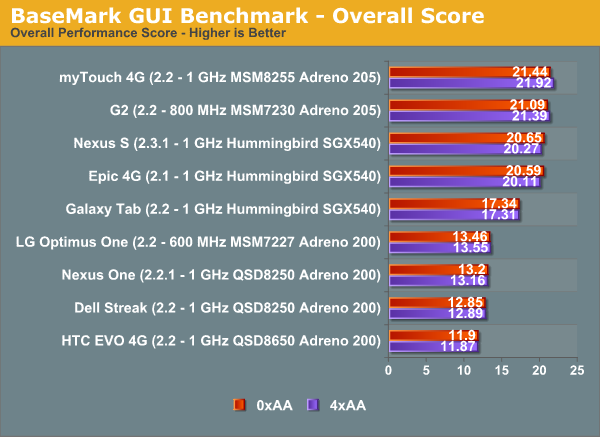
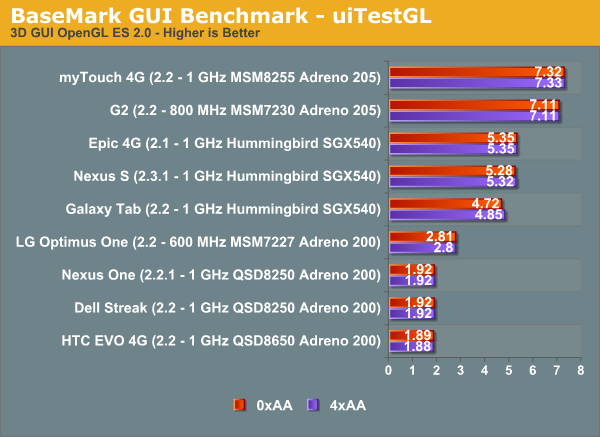
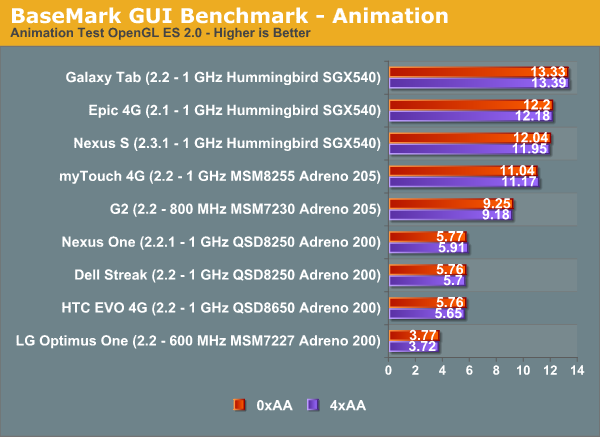
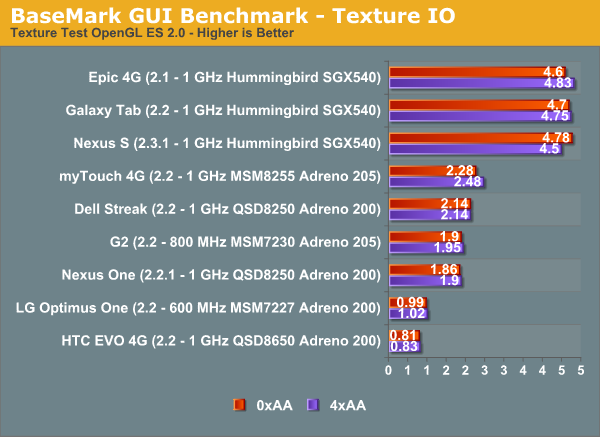
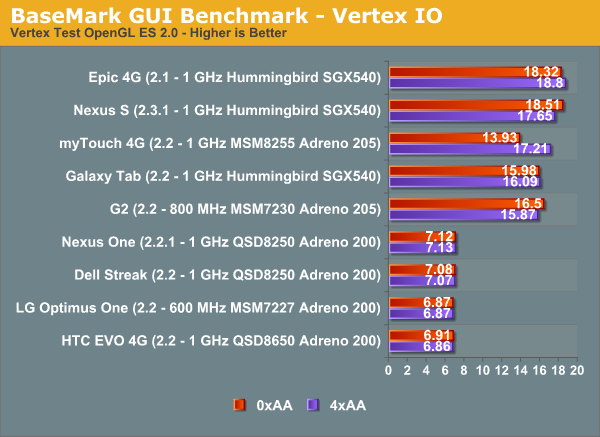
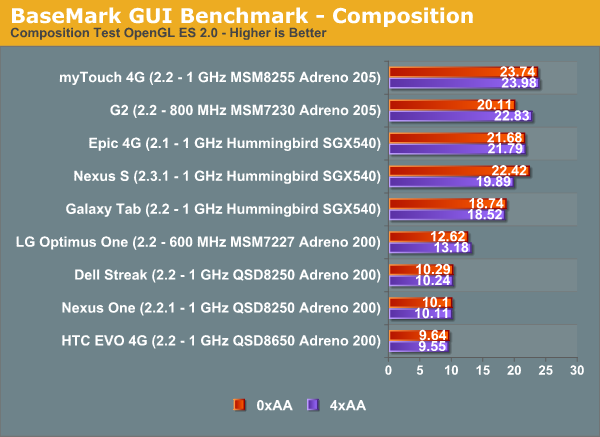
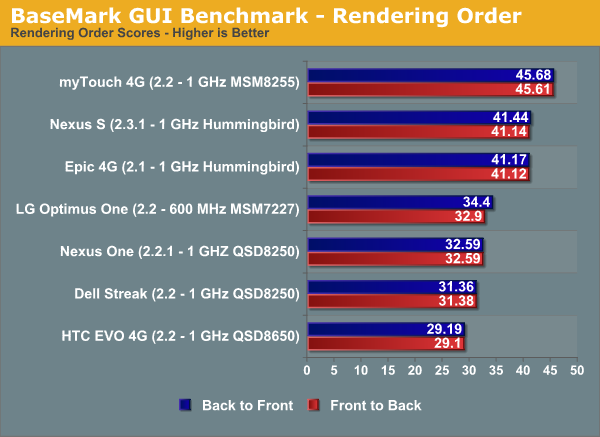
Results here are pretty interesting, and we see the Adreno 205 pull ahead of PowerVR SGX 540 in a few areas, which is surprising considering its substantial lead in our other tests like Quake 3 and GLBenchmark 2. In addition, the results immediately show that 4xAA is essentially free on all these tile-based renderers - results are within the margin of error for virtually all of these tests. Remember that thanks to tile-based rendering, little extra memory bandwidth is required for doing AA here. This is just one of the areas where tile-based architectures shine.
The Nexus S is a bit crashy throughout this benchmark, no doubt due to how new Android 2.3 is, and the Tegra 2 ViewSonic tablet produced strange results inbetween constant crashing, so we discarded its scores. As soon as we get more stable and final hardware, we'll add those Tegra 2 results in a full review. For now however, this is just another tool we're adding to our suite.
















20 Comments
View All Comments
strikeback03 - Tuesday, January 11, 2011 - link
Not knowing who they get their test phones from (carrier, manufacturer, or both depending on circumstance) they just might not have any Verizon or Motorola phones around anymore. Though that should really be remedied to have a TI SoC or two in tests like this.Could it be possible that the tests the Adreno 205 pulls ahead with are ones where the additions Qualcomm has made to the Scorpion CPU help it out over a standard A8?
metafor - Tuesday, January 11, 2011 - link
Since this is a GUI test, I suspect that is the case. Only specific functions can be run on the GPU, for most of the more complicated GUI work, the CPU is generally used.But I'd need to know more details about the test.
Brian Klug - Tuesday, January 11, 2011 - link
thornburg,strikeback03 has it exactly right - currently we're sampled by carriers, and most if not all of the time they want their devices back about a month after launch. Unfortunately, the result is that for tests like these that are new, we don't have much we can do other than test everything we have and try to snag older devices for comparison.
It's one of the things we're still working (a lot) on making better. :)
-Brian
DaFox - Tuesday, January 11, 2011 - link
I loved the music in that video. I had just left it open while it played out in the background.rsj56 - Wednesday, January 12, 2011 - link
agreed! wonder what/who the title/artist is...Mr Perfect - Tuesday, January 11, 2011 - link
Fascinating, Captain.austonia - Tuesday, January 11, 2011 - link
poor EVO... 6 months old and already bottom of the barrel. graphics are good enough for me but then i don't use it for gaming. Hopefully something with Tegra 2 is available this summer (upgrade every year with Sprint Premiere perks).silverblue - Tuesday, January 11, 2011 - link
...that the Adreno 205 was a tile-based renderer. I thought only PowerVR offered those. Still, you learn something new everyday. :)I also found out that AMD owned what is now the Adreno line until they sold it off to Qualcomm in 2008. I bet they're kicking themselves, especially considering they were good products even back then.
Huulio - Thursday, January 13, 2011 - link
I think it is more about benchmarking the whole system; GPU, CPU and disk performance in all together.Anyway it looks very nice :)
Loki7T1 - Thursday, February 3, 2011 - link
Hmm...this seems like a weak excuse. Seriously, you guys couldn't procure ANY OMAP-based devices? NONE? I would think that at the very least someone on the staff would own one.This does explain why all the Droid X benchmarks are with Android 2.1, though.
AnandTech is a great site and can do better.